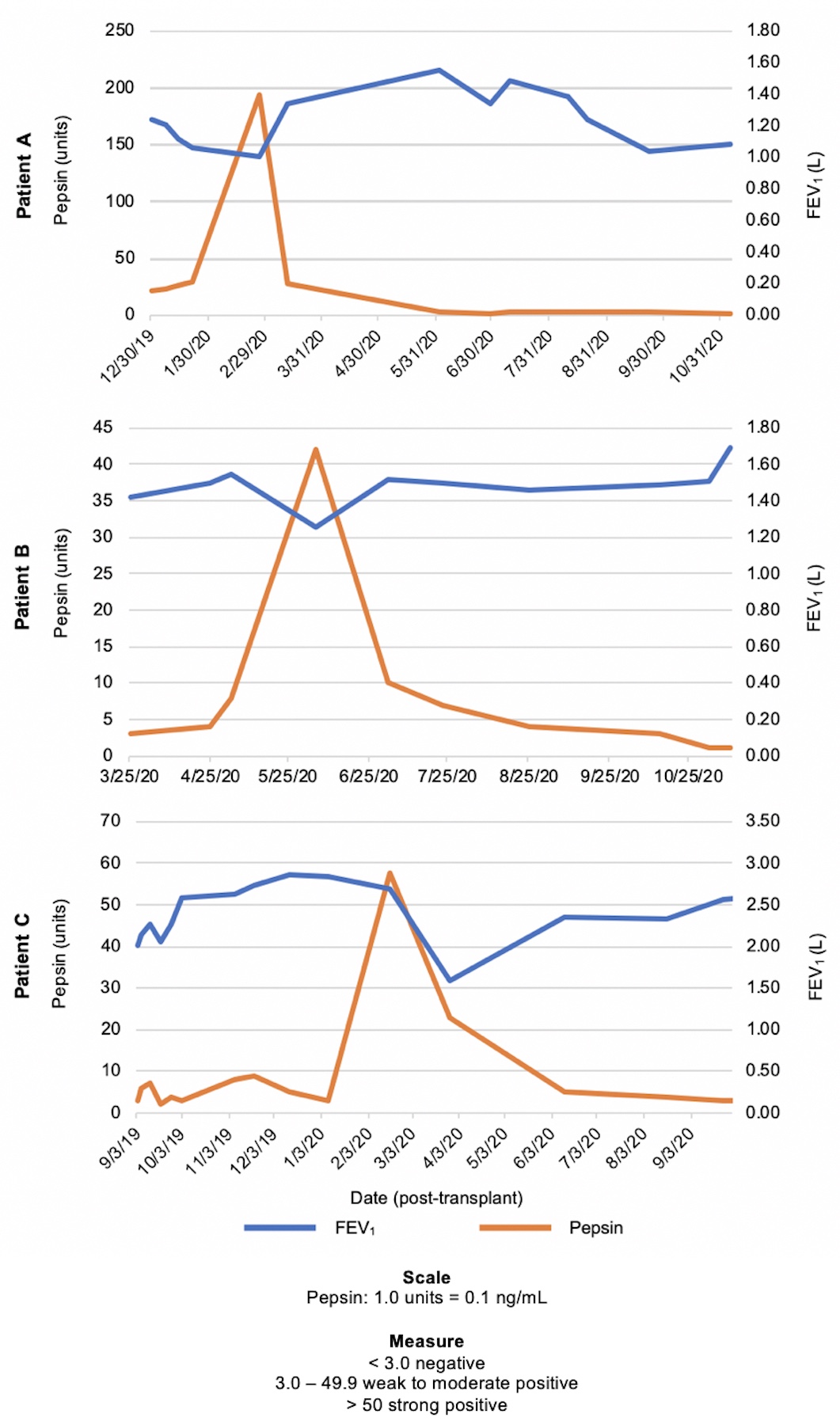Evaluation of Pepsin in Bronchoalveolar Lavage Fluid Post-lung Transplantation: Implications of Detection
Norton Thoracic Institute, St. Joseph's Hospital and Medical Center, Phoenix, AZ
Meeting: 2021 American Transplant Congress
Abstract number: 1210
Keywords: Lung transplantation
Topic: Clinical Science » Lung » Lung: All Topics
Session Information
Session Name: Lung: All Topics
Session Type: Poster Abstract
Session Date & Time: None. Available on demand.
Location: Virtual
*Purpose: This preliminary investigation in three lung transplant recipients aimed to measure pepsin, as a marker of gastric microaspiration, in bronchoalveolar lavage fluid (BAL) fluid, and relate its detection to gastroesophageal reflux disease (GERD) status, acute cellular rejection (ACR) episodes, and trends in pulmonary function.
*Methods: We analyzed BAL washings and transbronchial biopsies obtained during post-transplant surveillance bronchoscopies for quantitative pepsin levels and acute rejection episodes, respectively. Gastroesophageal function was evaluated pre-transplant and at 3-months post-transplant. Our preliminary investigation included three bilateral lung transplant recipients with pre-transplant GERD (DeMeester scores ≥14.7): 48-year-old female with scleroderma-related interstitial lung disease (patient A), 76-year-old male with combined pulmonary fibrosis and emphysema (patient B), and 73-year-old male with nonspecific interstitial pneumonia (patient C).
*Results: Pre-transplant GERD evaluation revealed esophageal peristalsis, delayed esophageal emptying, and DeMeester score of 50.0 in patient A, and mild esophageal dysmotility in patients B and C, with DeMeester scores of 32.4 and 17.5, respectively. One-month transbronchial biopsy findings were consistent with mild (A2B0) ACR in patient A, and no ACR in patients B and C. Post-transplant GERD evaluation revealed esophageal aperistalsis and DeMeester score of 86.7 in patient A, hypertensive lower esophageal sphincter with normal motility, but DeMeester score of 27.8 in patient B, and grossly normal esophageal function without GERD in patient C. Six-month transbronchial biopsies did not show ACR in any patients. One-year and 15-month transbronchial biopsies were available for patient C and showed two episodes of mild (A2B0) ACR. Elevated pepsin quantities detected in BAL washings and pulmonary function trends are shown in Figure 1.
*Conclusions: These early findings demonstrate the utility of measuring pepsin quantity in BAL fluid post-lung transplant. Its quantity on serial detection in lung transplant recipients may have relation to GERD status, acute rejection episodes, and pulmonary function. It also provides confirmatory evidence of reflux-induced microaspiration.
To cite this abstract in AMA style:
Olson MT, Rogers C, McAnally K, Arjuna A. Evaluation of Pepsin in Bronchoalveolar Lavage Fluid Post-lung Transplantation: Implications of Detection [abstract]. Am J Transplant. 2021; 21 (suppl 3). https://atcmeetingabstracts.com/abstract/evaluation-of-pepsin-in-bronchoalveolar-lavage-fluid-post-lung-transplantation-implications-of-detection/. Accessed December 15, 2025.« Back to 2021 American Transplant Congress

